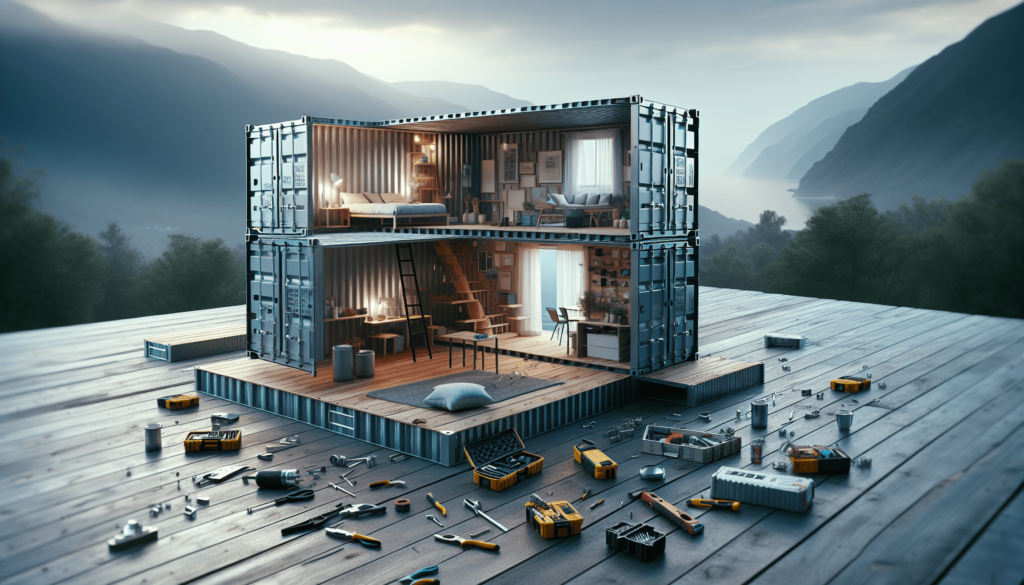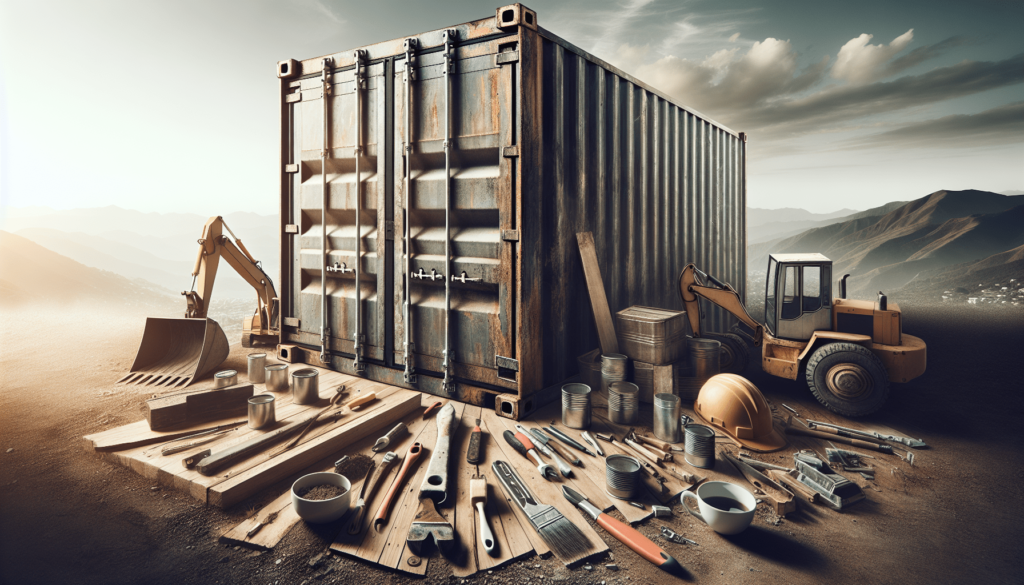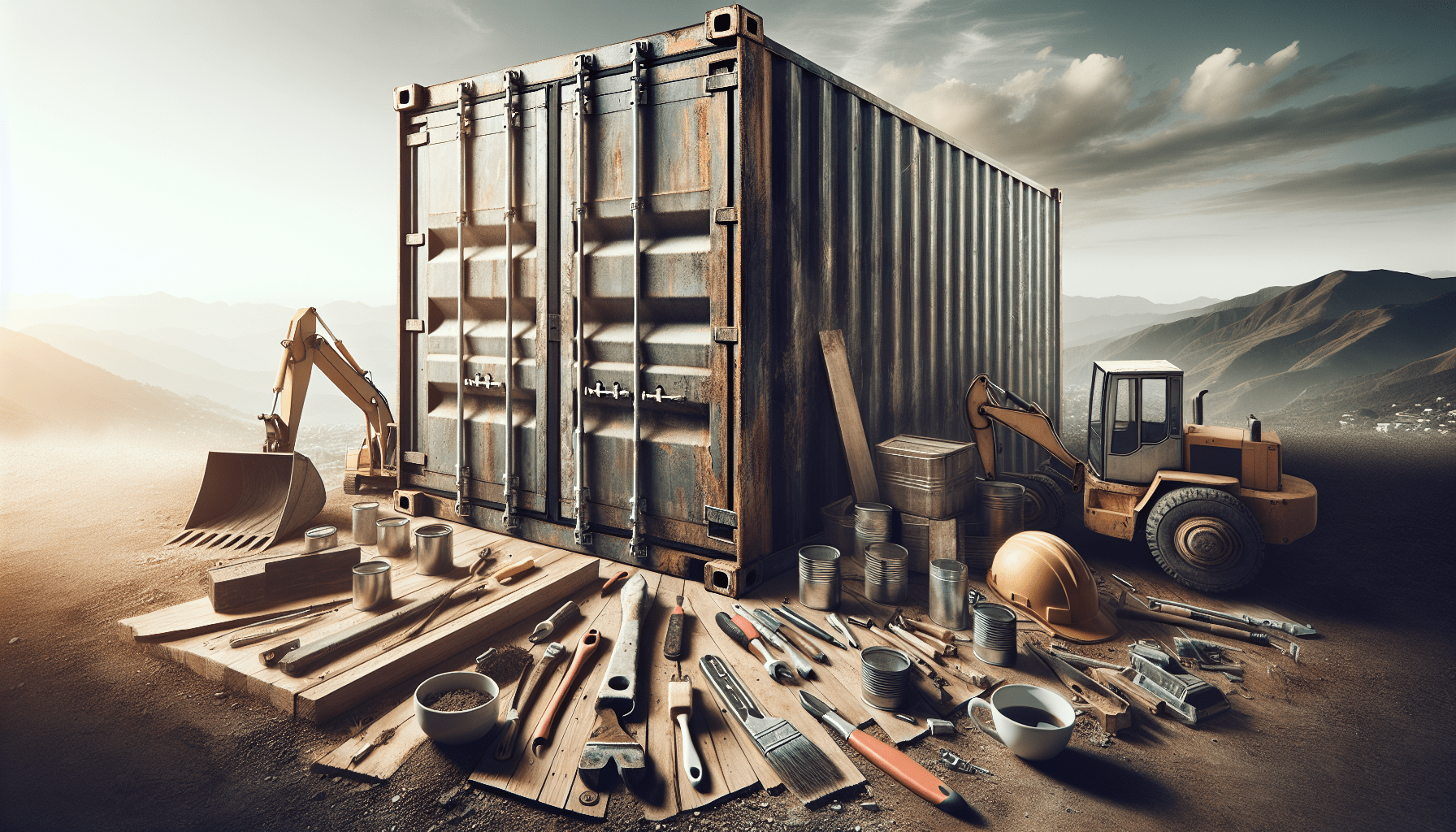Thinking about building your own home? One fascinating option to consider is a container home. You might be wondering, “Can I build a container home myself?” Well, the answer is a resounding yes! With a little bit of planning, determination, and some help from professionals, you can embark on this exciting journey and create a unique and sustainable living space that reflects your personality and lifestyle. Whether you have experience with construction or are a complete novice, building a container home yourself is not only feasible but also a rewarding and cost-effective way to turn your dream home into a reality. So, let’s explore the possibilities and discover how you can transform shipping containers into your own cozy sanctuary.

Benefits of Building a Container Home
Cost-effective
Building a container home can be a cost-effective alternative to traditional housing options. Shipping containers are readily available and relatively inexpensive compared to building materials for a conventional home. Additionally, container homes can require less labor and time to construct, further reducing costs.
Eco-friendly and Sustainable
Container homes are an excellent choice for environmentally conscious individuals. By repurposing shipping containers, you are giving them a second life and reducing the need for new construction materials. Additionally, container homes can be designed to be energy-efficient, incorporating sustainable features such as solar panels and rainwater collection systems.
Quick Construction
One of the significant advantages of building a container home is the speed of construction. With a solid plan and the right equipment, you can have your container home completed in a fraction of the time it takes to build a traditional house. This is especially beneficial for those who need a quick housing solution or want to minimize disruption during the building process.
Versatile and Customizable
Container homes offer a great level of versatility and customization. With the ability to stack and arrange containers in various configurations, you can create a home that suits your unique needs and preferences. Whether you desire an open-concept layout, multiple levels, or specialized rooms, container homes can be easily customized to fulfill your vision.
Understanding the Basics
What is a Container Home?
A container home is a dwelling constructed using shipping containers, which are large, sturdy, and stackable metal boxes often used to transport goods internationally. These containers provide a solid structural foundation for building homes and can be modified to accommodate all the necessary features of a traditional house.
Types of Container Homes
There are several types of container homes to consider when embarking on your construction project. The most common options include single-container homes, multiple-container homes, and container cluster homes. Single-container homes are the simplest and most cost-effective, while multiple-container homes allow for more space and design flexibility. Container cluster homes consist of multiple containers connected or stacked to create a larger living area.
Obtaining Suitable Land
Before starting your container home project, it is crucial to ensure you have suitable land for construction. Consider factors such as zoning regulations, access to utilities, and soil conditions. Research local regulations and consult with relevant authorities to determine the feasibility of building a container home on your desired property.
Understanding Local Building Codes
When planning your container home, it is essential to familiarize yourself with local building codes and regulations. Each area may have specific requirements for construction, including permits, safety standards, and design guidelines. Ensure that your container home adheres to these regulations to avoid any legal or safety issues later on.
Steps to Building a Container Home
Design and Planning
The first step in building a container home is to create a design and plan that aligns with your vision and meets your specific needs. Consider factors such as the layout, number of containers required, and any desired customization. It is advisable to work with an architect or designer experienced in container home construction to ensure an efficient and functional design.
Purchasing Shipping Containers
Once you have a design in place, you will need to purchase the shipping containers for your home. Look for reliable suppliers who can provide containers in good condition. Take into account the size, condition, and compatibility of the containers with your design specifications. Consider factors such as structural integrity, waterproofing, and aesthetics when selecting containers.
Site Preparation
Preparing the site for your container home is a crucial step in the construction process. Clear the area and ensure there is proper drainage to prevent issues with standing water. Level the land and remove any debris or obstacles that may interfere with the placement of the containers. Proper site preparation will ensure a stable foundation for your container home.
Foundation and Structural Considerations
The foundation for your container home can vary depending on the site and local regulations. Common foundation options include concrete footings, piers, or a slab foundation. Consult with a structural engineer to determine the most suitable foundation type for your specific location. Ensure that the foundation provides stability and meets all safety requirements.
Cutting and Framing
To create openings for doors, windows, and any other desired features, cutting and framing of the shipping containers is necessary. It is important to work with experienced professionals or follow detailed instructions to ensure proper cutting and framing while maintaining the structural integrity of the containers. Reinforce the openings with suitable framing materials to ensure stability.
Insulation and Ventilation
Proper insulation and ventilation are essential for creating a comfortable and energy-efficient living space. Insulate the interior of the containers using suitable insulation materials to regulate temperature and minimize heat transfer. Implement effective ventilation systems, such as windows, vents, or HVAC units, to ensure proper air circulation within the container home.
Electrical and Plumbing Work
Installing electrical and plumbing systems requires careful planning and professional expertise. Consult with licensed electricians and plumbers to design and install these essential systems. Ensure that all electrical and plumbing work complies with local building codes and safety standards. Proper installation will ensure a functional and safe container home.
Interior Finishes and Customization
Once the structural and functional aspects of the container home are complete, you can focus on interior finishes and customization. Choose suitable materials for flooring, walls, and ceilings based on your design preferences and budget. Consider incorporating storage solutions or built-in furniture to optimize space within the container home. Personalize the interior with colors, textures, and decorations that reflect your style and personality.
Tools and Equipment Needed
Basic Tools
Building a container home requires a range of basic tools such as hammers, screwdrivers, drills, saws, and measuring tapes. These tools are necessary for general construction tasks, cutting and framing the containers, as well as installing fixtures and finishes.
Specialized Equipment
In addition to basic tools, you may also need specialized equipment depending on the complexity of your container home project. This can include welding equipment for reinforcing and joining containers, heavy-duty machinery for site preparation, and specific tools for electrical and plumbing work.
Safety Gear
When working on a construction project, safety should be a top priority. Invest in safety gear such as hard hats, safety goggles, work gloves, and sturdy footwear to protect yourself from potential hazards. Ensure that you have proper ventilation and access to first aid supplies while working on your container home.

Challenges and Considerations
Building Permits
Before starting your container home project, it is important to secure the necessary building permits from local authorities. Failure to obtain permits can result in fines, delays, or even demolition of the structure. Research and comply with all permit requirements to ensure a smooth and legal construction process.
Dealing with Potential Structural Issues
While shipping containers are designed to be sturdy, it is essential to assess their structural integrity before using them for construction. Look for signs of rust, damage, or weak spots. Engage the services of a structural engineer to evaluate the containers and recommend any necessary reinforcements or modifications.
Understanding Local Climate Considerations
When building a container home, it is vital to consider the local climate and its impact on the structure. Extreme temperatures, high humidity, or frequent seismic activities can affect the durability and comfort of the container home. Implement appropriate insulation, ventilation, and structural reinforcements to ensure the home can withstand the local climate conditions.
Properly Insulating the Container
Insulation is crucial for maintaining a comfortable indoor environment in a container home. Without proper insulation, containers can become extremely hot or cold depending on the external weather conditions. Use insulation materials that have the appropriate R-value for your climate and follow best practices for insulating the walls, roof, and floor of the containers.
Addressing Moisture and Condensation
Containers are susceptible to moisture and condensation issues, which can lead to mold, corrosion, and other structural problems. Implement moisture barriers, such as vapor barriers and proper sealing, to prevent moisture from entering the container. Consider installing proper ventilation systems to control humidity levels and promote air circulation within the container.
Ensuring Sufficient Ventilation
Adequate ventilation is essential for air quality and comfort inside the container home. Incorporate windows, vents, and exhaust fans to facilitate the exchange of fresh air and remove stale air and odors. Proper ventilation will help regulate temperature, control humidity, and prevent condensation and mold growth.
Connecting to Utilities
Container homes require connections to utilities such as electricity, water, and sewer systems. Consult with professionals to ensure proper installation and connection of these services. Determine the feasibility and cost of connecting to existing utilities or consider alternative options such as off-grid solutions, such as solar panels and self-contained water storage systems.
DIY vs. Hiring Professionals
Budget Considerations
Building a container home yourself can be more cost-effective compared to hiring professionals, as you can save on labor costs. However, DIY projects may require more time and effort on your part, and additional costs may arise due to lack of expertise or mistakes. Consider your budget carefully and weigh the pros and cons before deciding to tackle the project yourself.
Time and Effort Required
Building a container home yourself requires dedicating a significant amount of time and effort. You will need to research, plan, and oversee every aspect of the construction process. If you have the necessary skills, time, and dedication, pursuing a DIY approach can be rewarding. However, if you have time constraints or limited construction experience, hiring professionals can save you both time and headaches.
Skills and Experience
Constructing a container home requires a certain level of construction knowledge and skills. Assess your own abilities and experience honestly before deciding to build a container home yourself. If you have little or no construction experience, it is advisable to hire professionals to ensure the structural integrity and safety of your container home.
Legal and Safety Aspects
Building a home involves compliance with local building codes and regulations. If you choose to build a container home yourself, it is essential to educate yourself on these requirements and ensure that you follow all necessary guidelines. Hiring professionals can alleviate the burden of navigating legal and safety aspects, as they are familiar with the laws and regulations surrounding construction.
Seeking Professional Help
Hiring an Architect
If you prefer a more hands-off approach, hiring an architect can simplify the container home construction process. An architect can help translate your ideas into a comprehensive design plan, taking into account structural considerations, local regulations, and your specific requirements. They can also assist in obtaining necessary permits and coordinating other professionals involved in the project.
Working with a Contractor
A contractor plays a crucial role in overseeing the construction process of your container home. They can manage the entire project, ensuring that timelines are met, materials are sourced, and work is completed to the required standards. Hiring a reputable contractor with experience in container home construction can save you time, effort, and potential headaches.
Engaging Structural Engineers and Inspectors
Structural engineers and inspectors are essential professionals in ensuring the safety and stability of your container home. Engage their services to conduct thorough evaluations of the containers, foundation, and overall structure. They can provide recommendations and guidance on reinforcements and modifications required to meet building codes and safety standards.
Consulting Local Authorities
Consulting with local authorities, such as building departments and zoning boards, is essential throughout the container home construction process. They can provide guidance on building codes, permit requirements, and any restrictions or limitations specific to your area. Maintaining open communication and seeking their advice can prevent costly mistakes and delays.
Cost Estimation
Container Purchase and Delivery
The cost of purchasing shipping containers for your container home will vary depending on factors such as size, condition, and location. On average, used containers can range from $1,500 to $5,000 each. Factor in delivery costs based on the distance from the supplier to your site.
Site Preparation and Foundation
Site preparation costs can include land clearing, excavation, leveling, and utility connections. Depending on the condition of the site and complexity of the work, site preparation costs can range from a few thousand dollars to tens of thousands of dollars. The foundation cost will depend on the type of foundation chosen, with options such as concrete footings or a slab foundation varying in price.
Construction Materials and Finishes
The cost of construction materials and finishes for a container home will depend on factors such as the size of the home, desired features, and quality of materials. Budget for materials such as insulation, framing materials, electrical and plumbing fixtures, flooring, and interior finishes. Consider both the cost of materials and any professional installation fees where applicable.
Labor and Professional Services
If you choose to hire professionals for certain aspects of the construction process, such as cutting and framing or electrical and plumbing work, budget for their labor fees. Additionally, factor in any professional services required, such as architectural design, engineering consultations, and permit fees.
Permits and Inspections
Obtaining permits and undergoing inspections can incur costs. Permit fees vary depending on locality, and additional fees may be associated with inspections to ensure compliance with building codes and regulations.
Unexpected Expenses
It is essential to budget for unexpected expenses and contingencies during the construction process. Unforeseen issues may arise, necessitating additional materials, labor, or professional services. Allocate a buffer in your budget to account for these unforeseen circumstances.
Tips for Successful DIY Container Home Construction
Thorough Research and Planning
Before starting your DIY container home project, conduct thorough research. Familiarize yourself with every aspect of container home construction, from design considerations to local regulations. Create a detailed plan, including a timeline and budget, to ensure a smooth and efficient construction process.
Taking Measurements and Accurate Calculations
Precise measurements and calculations are vital when working with containers and planning the layout of your container home. Double-check all measurements and ensure they align with your design plans. Even minor inaccuracies can lead to significant problems during construction.
Seeking Advice and Assistance from Experts
While DIY construction can be rewarding, do not hesitate to seek advice and assistance from experts when needed. Consult with architects, structural engineers, and other professionals to ensure your container home is structurally sound and complies with all necessary regulations.
Keeping Safety a Priority
Safety should always be a priority when constructing a container home. Invest in proper safety gear, follow best practices for construction and tool usage, and ensure that you are aware of potential hazards and how to mitigate them.
Managing the Construction Timeline
Creating a realistic timeline is essential for managing a DIY container home project effectively. Break down the construction process into achievable tasks and set realistic deadlines for each phase. Continuously monitor progress and adjust the timeline as required to ensure smooth progress.
Maintaining Open Communication with Local Authorities
Maintaining open communication with local authorities throughout the construction process is crucial. Seek guidance and ensure that you are complying with all necessary building codes and regulations. Promptly address any concerns or requests for information from local authorities.
Conclusion
Building a container home yourself can be a rewarding and cost-effective option for those with the necessary skills and knowledge. It offers the benefits of cost-efficiency, sustainability, quick construction, and versatility. However, careful planning, understanding of local regulations, and proper execution are crucial to ensure a safe and comfortable living space. Consider the challenges, budget, and your own capabilities before deciding between a DIY approach or seeking professional assistance. With the right preparation and execution, a container home can provide a unique and stylish living space that meets your specific needs.

I am James, the creator behind SeaBoxInnovations.com. Welcome to our premier online destination dedicated to the world of sea containers. Think Inside the Box is our tagline, and our website is your go-to source for exploring the endless potential of these versatile and adaptable containers. Whether you’re interested in purchasing, customizing, or learning about the latest trends in container architecture and design, we have you covered. Join us as we bridge the gap between traditional uses and cutting-edge applications, promoting sustainability and innovation in design and construction. Get ready to embark on your next big project with SeaBoxInnovations.com.

